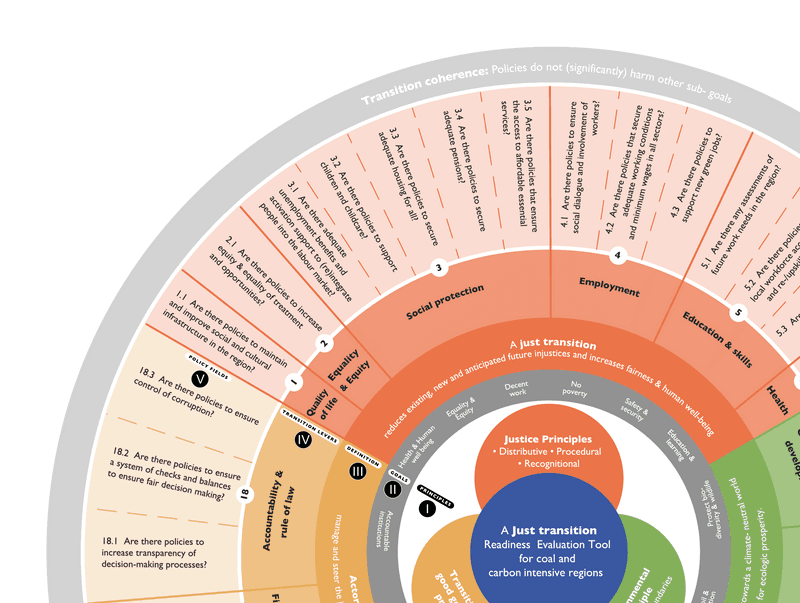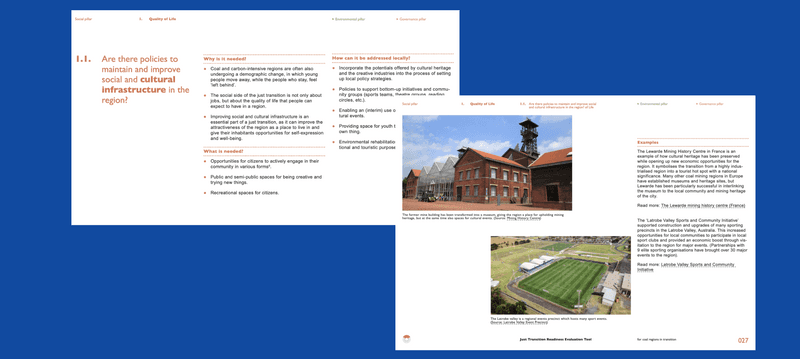22. November 2023Just Transition, but implemented? Why a whole-systems approach is needed
While the decarbonisation of the energy sector is slowly gaining pace, just transition implementation in coal and carbon intensive regions is often a black box, lacking a basic consensus about its goal and focus. CINTRAN’s new Just Transition Readiness Evaluation Tool aims to open that black box by identifying policy areas & approaches that are relevant for a just transition on the local level as a first step to truly advance on implementation.
While governments are starting to initiate new policies to provide the frameworks for a transition towards climate neutrality, many trade unions, civil society actors and non-governmental organisations are also increasingly pointing towards a need to apply principles of ‘just transitions’ to frame the transformation. Focusing more on a transition justice lens is seen as necessary, as impacts of systemic shifts towards a climate-neutral society will very much affect people’s way of living at its core, and without further measures bear the risk that costs and benefits of the transition will be unfairly distributed.
What does “just” in just transition actually mean?
At first, just transition as a concept was developed by trade unions, but has since been endorsed by a range of organisations and political actors to add a social lens to the climate and environmental policy discussion. However, there is no single, universally accepted approach or definition of just transition to date. The concepts range widely from an understanding that can be described as a ‘status-quo transition’, focusing on providing new jobs and new economic development to more ambitious approaches aiming at deeper structural reforms and a transformation that also addresses injustices such as gender inequality that are caused by the structure of today’s society (see figure 1).

Figure 1: Four possible levels of just transitions. Source: The Future Centre, based on JTRC 2018
During our research and in discussion with stakeholders from coal and carbon intensive regions over the last years, we experienced that when stakeholders were talking about just transition, the debate was often not only about the fairness of the strategy development process and coal worker’s compensation schemes. Instead, very quickly the discussion shifted towards the ‘big questions’: How can the region improve the livelihood of their people? Who will be affected by the changes that are happening within the transition? But also: How can the region reduce existing injustices and tackle problems that have been existing in the region for a long time?
Especially this last question is pointing towards the use of a more holistic understanding of just transition and a need to also address systemic causes of injustices that are not directly linked to the energy transition. It appears to be obvious, but in fact many stakeholders want more than keeping the status quo, and instead develop their regions in a way it becomes a better place for its people. The question is, can this be achieved when existing injustices and problems in the regions remain unaddressed? Are the policy mixes that are currently being developed good enough to truly implement a just transition in a way that people in the region will see them as successful?
A whole-systems perspective can guide policy development to tackle multiple problems at once
This is why we developed the Just Transition Readiness Evaluation Tool (JT:READY) for coal and carbon intensive regions (Figure 2). The tool should enable policy makers and stakeholders to understand the actual complexity of the just transition concept and how it can be broken down into transition-related policy fields and measures at the regional level. Linking just transition research with overarching EU climate and social policy goals, we propose a framework that is based on what scholars call a ‘whole-systems approach’ (Abram et al., 2022) to just transition. A whole-systems perspective goes beyond current status quo approaches and instead actively aims to take into account systemic root causes for existing injustices to realise a just transition in a way that is fair for all.

Figure 2: A visualisation of the JT:READY framework. The tool can be read from the inside to the outside, subsequently presenting a way of how to start from principles to identify policy areas and measures for just transition implementation. Source: Wuppertal Institute 2023
Identifying relevant policy areas for just transition implementation & examples for policy responses at the local level
The tool is designed following a step-by-step logic, starting at the very beginning with the principles of just transition (I), why there needs to be a transition in the first place and what exactly ‘just’ means, and then subsequently arguing how those can guide the identification of transition goals (II), levers (III) and policy fields (IV). At the core, the tool provides a comprehensive overview about the themes and topics that play a role for just transition policy development and suggestions and examples for policy responses.
By using the JT:READY tool, local stakeholders can analyse the following:
- Completeness of just transition planning: Which aspects of a (whole-systems) just transition are currently already addressed, and which areas were overlooked?
- Mandate to make changes: In which areas does the region or municipality have the authority to develop own policies and in which areas do they need to coordinate (more) with higher political levels?
- Instruments for steering the transition: What could be levers to steer development towards just transition in the areas that have not been addressed yet?
- Priorities for getting started: What are the priorities for developing local policy instruments, given that most likely not all challenges can be tackled at the same time?
Finding answers to those questions will be especially important to develop regional transition strategies, e.g., by clarifying what just transition understanding the region has, how civil society integration can be further supported (if underdeveloped in current transition readiness), or strengthening social aspects in existing legislation based on transition justice considerations.
Realising a just transition that is both fully in line with planetary boundaries and perceived as just is by far not easy, but necessary. With JT:READY, stakeholders now have a powerful tool at hand to support them in this process.


Figure 3: Navigating the Just Transition Readiness Evaluation Tool. Source: Wuppertal Institute 2023
Related Publication
You can find the tool here.
Author
Jannis Beutel
Researcher | Wuppertal Institute for Climate, Environment and Energy
Division Future Energy and Industry Systems


Funding
The CINTRAN project has received funding from the European Union’s Horizon 2020 research and innovation programme under grant agreement No. 884539. The sole responsibility for the content of this website lies with the authors and does not necessarily reflect the opinion of CINEA or other EU agencies or bodies.